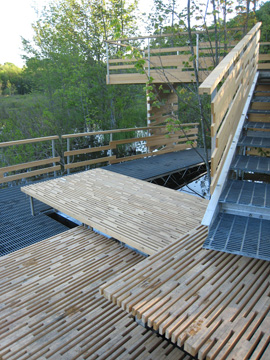Students Create Innovative Structure for Audubon Society

Imagine this architectural challenge: create a site-appropriate structure for a former cranberry bog covered with 3 feet of water; use durable and sustainable materials and construction technologies as extensively as possible; work within a budget and; make it optimal for observing Redwing Blackbirds, Scarlet Tanagers, Hooded Mergansers, and the occasional Great Blue Heron.
The task would certainly be a considerable undertaking for a seasoned architect, but the Mattabeseck Audubon Society commissioned a group of Wesleyan students who were only a few weeks into their second college-level architecture class.
The result is “SplitFrame,” a bird-viewing platform in the Helen Carlson Wildlife Sanctuary in Portland, Conn. SplitFrame will be celebrated by a reception for the project at 2 p.m. on Oct. 19 at the Sanctuary.
SplitFrame capped an intensive semester-long process involving student research, design and client presentations. The ambitious project was undertaken during the university’s 2008 spring semester by sophomores, juniors, and seniors enrolled in Architecture II, the second in a sequence of undergraduate design studios taught by Elijah Huge, Assistant Professor of Art.
The Architecture Research-Design-Build Studio is a new initiative for Wesleyan.
“The class was basically an academic triathlon comprised of design research, real world testing of conceptual work developed in the studio, and community-based learning,” Huge says. “Going from sustainable materials and site research to project construction within a single semester, the process exemplified a successful collaboration involving wonderful clients, talented and committed students, and an incredible site.”
SplitFrame consists of two integral pieces, a floating Observation Deck and an elevated Viewing Station, that are connected by a hinged staircase. It is situated at the end of a long weir, a vestige of the wildlife sanctuary’s former use as a commercial cranberry bog.
Informed by research on sustainable construction technologies and building materials, design precedents, and the project’s 19-acre site, the studio worked collaboratively to develop and implement the project following the final client review in April.
Students constructed SplitFrame using only hand-held power-tools, and all on-site construction was completed without the use of heavy equipment.

“We had been struggling with a way to provide an optimal experience at our sanctuary, especially since a colony of beavers had changed the site to such a degree that access was a serious challenge,” says Mattabeseck Audubon Society President Alison Guinness. “This also became the challenge for Elijah Huge and his students, who have not only created a sustainable project but put in long hours under adverse conditions. When other students were enjoying the spring season, the architecture class was knee deep in mud and water, swatting mosquitoes, and dripping with sweat or rain. We were impressed by their architectural skills, professionalism and dedication to the project, and we are very grateful that our sanctuary is once again available for a unique environmental experience.”
Using an innovative pre-cast concrete pin-foundation system for the elevated viewing station and a floating aluminum frame assembly for the observation deck on the water, the project was designed to minimize its impact on the site, both in construction and over the projected life of the structure.
Together, the two platform components provide an immersive site experience, bringing visitors out onto the water, and offering an overview of the sanctuary from the maple tree canopy above.
For more information about the dedication event or the structure, contact Elijah Huge at ehuge@wesleyan.edu.

